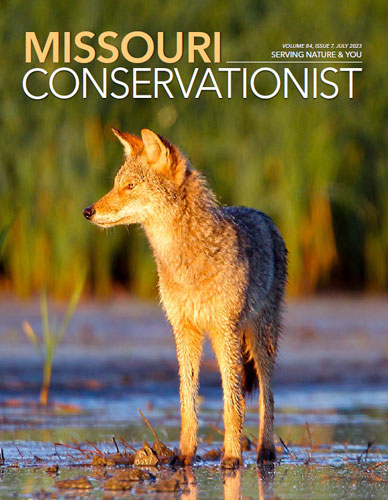Got a question for Ask MDC? Send it to AskMDC@mdc.mo.gov or call 573-522-4115, ext. 3848.
Q: What type of frog is this?
This is a pickerel frog. They can be common around homes in dry, summer months. This amphibian is attracted to water features. Pickerel frogs spend most of their lives on land and go to water to breed in late winter or early spring. However, they seek out plants and gardens, watered by people, in the summer. They overwinter beneath the ground in karst areas throughout much of the state, especially in caves with running streams.
Pickerel frogs typically have paired squarish markings on their backs with broad dorsolateral folds. These paired markings are usually more prominent on the frogs’ lower ends. The paired markings on this frog — along with a brightly colored groin area — are typical for this species. For more information, visit short.mdc.mo.gov/4dE.
Q: I associate dragonflies with water. Last year, we experienced a massive drought in southeast Missouri. So why did I have thousands of dragonflies?
While dragonflies do need water for the first portion of their lives in the egg and larval stage, when they emerge as adults, they can go wherever the food takes them. As insectivores, many dragonfly species will loiter near the insect-rich wetlands from which they emerged; however, venturing 3 miles away to forage isn’t unheard of.
Dragonflies’ foraging strategies add another nuance, explaining why some species may be found closer or further away from water. Some species are perchers and wait for prey to fly by while others are fliers and zip around looking for prey. Those species falling within the fliers’ group are the ones most often seen patrolling upland areas looking for a meal. To add another wrinkle, some migratory species travel hundreds of miles during the adult stage.
In the Sikeston area, July is the time of year when gliders emerge from rice paddies and other fishless, lowland ponds. Where mating occurs is hard to know — presumably away from water and on the wing — but they’ve been observed attempting to oviposit or lay eggs on anything remotely reflective, including cars in a parking lot.
Newly emerged adults typically fly away for a week or more to mature before returning to the water. To learn more about dragonflies, visit short.mdc.mo.gov/4db.
Q: I found tiny mussel shells in a house pod vacated by purple martins. Were they fed to the hatchlings?
Yes. A purple martin’s insectivorous diet offers adequate protein but skimps on calcium. Hence, the birds eat mussels as grit and calcium, regurgitate them, and feed them to their offspring. Observers have noted seeing clam shells, fish bones, snail shells — and, yes, mussel shells — in the birds’ nesting cavities. For more information, visit short.mdc.mo.gov/4da.
Q: My friend found this in her garden. Is it a moth? A chrysalis? It’s quite large!
These are imperial moths (Eacles imperialis). They are mating. It looks like the male found the female before she was fully “eclosed” — or emerged from the pupal case — as her wings have yet to be inflated. In Missouri, these moths feed on maples, sycamores, and sassafras. Females have less brown on their wings, are larger, and can be 5.5 inches.
For more information, visit short.mdc.mo.gov/4dL.
And More...
This Issue's Staff
Editor - Angie Daly Morfeld
Associate Editor - Larry Archer
Photography Editor - Cliff White
Staff Writer - Kristie Hilgedick
Staff Writer - Joe Jerek
Staff Writer – Dianne Van Dien
Designer - Shawn Carey
Designer - Marci Porter
Photographer - Noppadol Paothong
Photographer - David Stonner






















